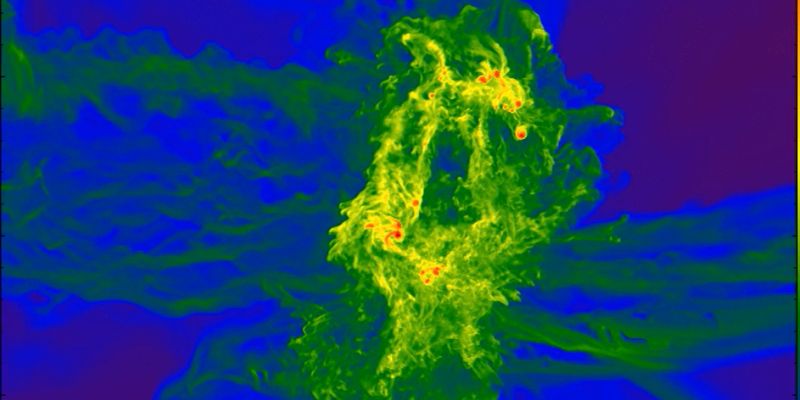New research shows how black holes with tens of thousands of Suns’ worth of mass can form in the universe’s early years.
Just 700 million years after the Big Bang, when the universe was still in its infancy, we already see supermassive black holes with the heft of 1 billion Suns. How could they have grown so fast? A team of astronomers is using computer simulations to glimpse what the formation of these dark behemoths might have looked like.
How to Make a Supermassive Black Hole
If you wish to make a billion-solar-mass black hole from scratch, to borrow a phrase, you must start with a star — or perhaps only with the gas that stars are made of.
While the universe’s first stars might have made the first black holes, those would have been relatively small on the supermassive scale, with masses of only around 100 Suns. Perhaps the first stars clustered and so when stars made black holes, those black holes merged and then merged again. Even then, such black hole “seeds” would have been only 1,000, maybe 10,000 solar masses. These black holes would have had to grow super-fast to become supermassive in such a short amount of time.
But there’s another way: Some astronomers have put forward the idea that in the small early universe, when gas was dense and pristine, gas clouds could collapse directly into more massive black holes.
The calculations for such massive implosions are delicate, though. What’s to prevent pieces of the gas cloud from cooling and collapsing under their own weight, as star-forming clouds in the modern universe are wont to do?
Some astronomers have suggested the ultraviolet emission of nearby newborn stars might have heated the gas, keeping it too warm to fragment. Others have argued that such specific requirements would make the process too rare to explain the number of supermassive black holes we’ve already found in the young universe.
Keeping It Together
Now, Muhammad Latif (United Arab Emirates University), Daniel Whalen (Portsmouth University, UK, and University of Vienna), and colleagues report in Nature that massive black holes can form without these special conditions.
The finding relies on computer simulations, which rebuild the conditions of the infant universe, when it was around 100 million years old. Simulations are necessary because this era of the first stars is out of reach for our current telescopes.
The simulation followed the growth of a small, frothing sea of matter fed by four torrents of inflowing gas. While such nodes would have been common in the web of material filling the universe, Whalen says these streams were unusual because they carried so much gas. Latif adds that the rivers of gas were not only dense but fast-flowing; rushing in at speeds of 50 km/s (more than 100,000 mph), they carried between 1 and 10 Suns’ worth of material per year.

Daniel Whalen (Portsmouth University, UK)
The sea at the center of these streams of material grew, and within the sea a clump took shape, and then another. The turbulence of inrushing gas flows kept the massive clumps from collapsing straightaway into stars; instead, the clumps continued to grow. By the end of the simulation, they contained tens of thousands of Suns’ worth of mass.
Eventually, these clumps compress into what the researchers call supermassive stars; following their evolution requires a different kind of computer simulation, one that takes stellar physics into account. The stellar monstrosities don’t last long in this simulation, just 2 million years, before they collapse again into black holes of 30,000 and 40,000 solar masses, respectively.
Such massive seeds could easily collect more gas and grow to become the dark behemoths seen by astronomers. Even though the kind of confluence explored in this study is rare, Latif, Whalen, and colleagues estimate that it would occur often enough to explain observations.
“The new environment replete with cold flows that’s numerically explored in this study is very exciting,” says Priya Natarajan (Yale), “as it seems to provide a natural pathway for the formation of massive black hole seeds.”
But it isn’t the only scenario that results in direct collapse, she cautions. Natarajan, who wasn’t involved in the current study, explored a different scenario back in 2014, finding that a dense star cluster could similarly allow direct collapse to happen. “The upshot is that there are multiple pathways to rapidly amplify and make massive black hole seeds in situ and early in the universe.”
Upcoming James Webb Space Telescope observations, she adds, will help distinguish between the different black hole seed scenarios. Webb won’t be able to detect the supermassive stars, even though they’re millions of times more luminous than the Sun, but it’s possible it could detect the black hole seeds that are still growing when the universe is less than 200 million years old.
 1
1









Comments
RC Silk
July 15, 2022 at 5:48 pm
Every black hole is a "seed" of another universe, just as our universe is the flower of such a seed.
You must be logged in to post a comment.
You must be logged in to post a comment.